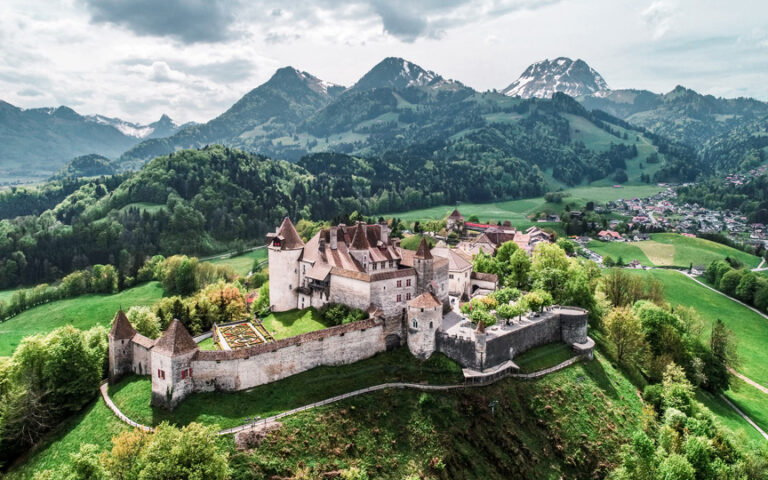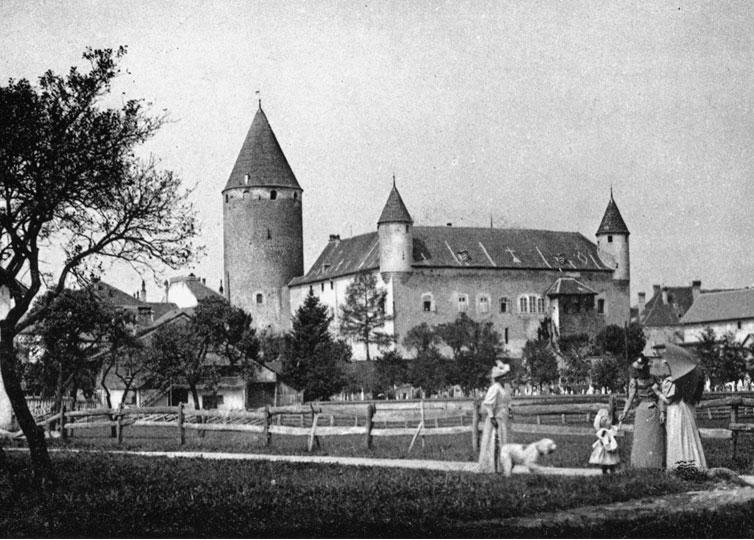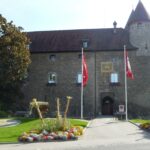Constructed from 1291 by the Bishop of Lausanne, the feudal lord of Bulle, the castle has retained its administrative vocation: it is occupied by the district prefecture, the court and the gendarmerie. The main tower reaches a height of 33 metres (108 feet). The inner courtyard is open to the public.
Foundation
Construction of the castle lasted forty years, begun by the Bishop of Lausanne Guillaume de Champvent in 1291 and completed in 1331. The purpose of the structure then was to defend Bulle against the claims of the Counts of Gruyères, vassals of Savoy, Counts of Savoy based in Châtel-Saint-Denis, and Louis de Savoie based in Romont; the latter attempted to gain a foothold in Vaulruz from 1302. In the Middle Ages the castle kept watch over one of the two main entrances to the town, the Porte d’Enhaut (upper gate). The Porte d’En bas (lower gate, located at the end of the Grand-Rue and demolished in 1805), the small Poterne entrance, and a rampart surrounding the existing historic town centre, completed the defensive fortifications.
Architecture
Although the town of Bulle was never directly subjected to domination by the feudal lords of Savoy, the castle’s builders drew inspiration from the latter’s military architecture, adopting a simple geometrical layout: a square with towers at all four corners, known as the “Savoy square”, which can be seen also in the castles of Romont, Morges and Yverdon in particular. The main tower is a 33-metre high keep with a diameter of 13.5 metres; at ground level, the walls are up to 2.16 metres thick. The original entrance to the tower is 9.7 metres above ground. Three other turrets overlook the castle’s walls. Without the large circular tower, the shape of the castle is almost square, 44 metres long and 41 metres wide. The north side (main entrance) and also the south and east sides are formed by three solid buildings; a no less robust enclosure forms the junction on the east side. This square is surrounded by a 17 metre wide moat. It is impossible to say if this moat was filled with water permanently or only in times of danger. We do know however that the Les Usiniers canal, the town’s only source of running water at the time, passed between the castle and the lime tree and provided the water required to fill the moat. The castle had a drawbridge at the end of the 18th century, the fixtures of which can still be seen on either side of the main entrance. The castle was spared by the two devastating fires of 1447 and 1805. Despite some renovation and modifications, it retains today the contours of a medieval fortress.
Use
In the Middle Ages, the Bishop of Lausanne was represented at the castle by a lord and a mayor. The lord had keep of the castle and maintained a court of law there; he also collected taxes owed to the overlord by the inhabitants of Bulle. The mayor assisted the lord of the castle and delivered summary justice. Arrangements were made to ensure that the Bishop could rely on twelve beds, installed in the building adjoining the hospital on the present-day site of the monastery, whenever he passed through Bulle.
From 1537, after annexation of the town of Bulle by Fribourg, the castle was the seat of Fribourg bailiffs, the predecessors of modern prefects. In the 18th century, to the left of the main entrance, on the side of the Church of Notre-Dame de Compassion, stands the pillory, a small building where people who committed minor transgressions were put in chains and left exposed, sentenced to public humiliation; on the right is the turnstile, a revolving cage used for the same purpose.
Conversions
Between 1763 and 1768, major work was undertaken inside the castle, in the bailiff’s apartment and in the reception hall. In the 18th century a series of buildings housing shops bordered the moat on the side of the lime tree. These shops were replaced in the second half of the 19th century by ever taller buildings that gradually concealed the castle from sight. These buildings were gradually demolished by the commune of Bulle from 1968.
In 1854, prisons were installed in the south wing of the castle. In 1946, new cells were added in the north-east corner. The castle was listed as an historic monument of national importance following a restoration campaign supervised by the Confederation between 1921 and 1930. To coincide with construction of the new Musée gruérien, a public footpath crossing the moat was opened in 1976.
Today, the castle is occupied by the prefecture of La Gruyère, the court and the gendarmerie. It is owned by the State of Fribourg. The inner courtyard is open to the public.
© Musée gruérien and Cultural Heritage Department of the canton of Fribourg
Also of interest
The sections “A living town” and “Contours in motion” of the permanent exhibition La Gruyère, footprints and detours, at the Musée gruérien.
Find out more
Daniel de Raemy, Châteaux, donjons et grandes tours dans les Etats de Savoie (1230-1330), Cahiers d’archéologie romande 1998, Volume 1.
Marc-Henri Jordan, Le château de Bulle, Pro Fribourg, n°93, 1991
Archive photo:
Bulle, the castle viewed from the east, circa 1910
© Charles Morel Musée gruérien



















